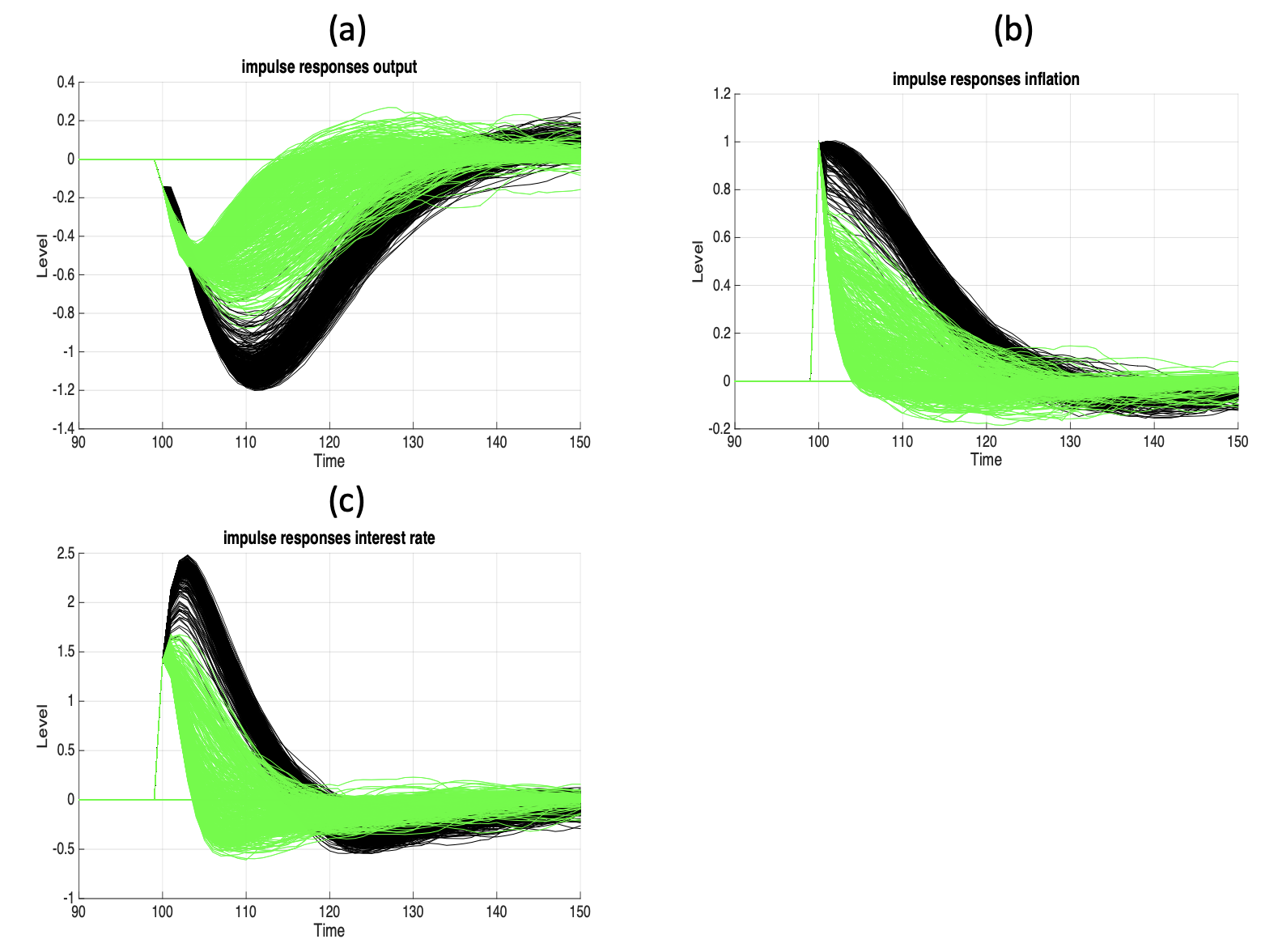The importance of trust in economic life is pervasive. Trust in the quality of institutions, trust in the executive and judiciary, and trust in a stable environment governed by the rule of law all affect the behaviour of economic agents and make them more willing to engage in contractual arrangements, to plan, and to invest. There is now a large literature documenting how trust matters for economic development and growth.1
Trust plays some role in standard macroeconomic models. These now typically incorporate a central bank that announces an inflation target. The credibility of this inflation target usually plays an important role in the effectiveness of monetary policies and in the transmission of shocks. Thus, it can be said that trust in the central bank matters for the way monetary policies and exogenous shocks are transmitted into the economy.
In our recent paper (De Grauwe and Ji 2022), we pursue the analysis of trust in macroeconomic modelling more systematically. First, we enlarge our definition of trust and assume it has two dimensions. The first dimension is an institutional one. It is the trust in the central bank that has announced an inflation target. We, therefore, use trust as a corollary of the credibility of the central bank. A central bank that has built strong credibility of its inflation target is an institution that is trusted when it promises price stability. A second dimension is trust in the future. We measure this by the degree of optimism about future economic activity. Trust here means a belief that future economic activity will be strong. Conversely, a lack of trust means that there is pessimism about future economic activity.
Second, we use a behavioural macroeconomic model (De Grauwe 2012, De Grauwe and Ji 2019) to analyse trust. This is a model which assumes that agents have cognitive limitations. They do not know the underlying structure of the model, nor do they know the distribution of the shocks that affect the economy. In such models with imperfect information, trust becomes of great importance to understand how shocks are transmitted and how monetary policies affect the economy.
Behavioural macroeconomic models generate endogenous dynamics of booms and busts in economic activity. These dynamics are driven by self-fulfilling movements of optimism and pessimism (animal spirits). The fundamental reason for the emergence of such dynamics is the fact that individuals have cognitive limitations preventing them from having rational expectations. This lack of understanding provides the basis of a mechanism in which individuals find it rational to use simple forecasting rules, check ex-post how well these rules have worked, and are willing to experiment with other rules when they observe that these work better. It also turns out that the shifting in the forecasting rules at the individual level generates a collective process of herding based on the fact that successful rules will be copied by others. It is this collective process that is at the core of the waves of optimism and pessimism driving the business cycle movements and influencing the credibility of the central bank. It also follows that trust becomes an endogenous variable.
Our main results can be summarised as follows. Focusing on negative supply shocks, we find, first, that when the negative supply shock is sufficiently large (three standard deviations or more), there exist two trajectories of output (see Figure 1). The first one, a ‘good’ trajectory (coloured green) implies a relatively small decline in the output gap and a relatively quick return to the steady-state value; the second trajectory, a ‘bad’ one (coloured black), follows a deep decline in output and a slower recovery. A similar bifurcation between good and bad trajectories is detected in the impulse responses of inflation generating a good trajectory of rapid declines in inflation and a bad trajectory characterized by a slower decline in inflation.
Figure 1 Impulse responses to a large supply shock (10 std)
Second, trust follows similar good and bad trajectories. We find that in all the bad trajectories of output and inflation, the credibility of the central bank drops to zero. Thus when the economy is on a bad trajectory, this coincides with a collapse of credibility. No single agent trusts the central bank anymore: the fraction of agents that use the inflation target as their forecasting rule drops to zero, and they all use an extrapolative rule to make inflation forecasts. At the same time, trust in the future of economic activity (animal spirits) also drops to its minimum value (extreme pessimism). These features are absent in the good trajectories. When the economy is on a good trajectory of output and inflation, our two measures of trust do not decline. This makes the good trajectory possible.
Third, we find that initial conditions matter a great deal in determining which trajectory will be chosen. In order to get stuck on a bad trajectory, the initial conditions must be bad, i.e. there must be high inflation expectations and pessimism about future output. These bad initial conditions make it possible for the large negative supply shock to push the system towards the limits of zero credibility and extreme pessimism. As a result, the mean-reverting processes in the forecasting behaviour of agents are switched off, and forecasting is purely extrapolative. This means that along this bad trajectory, the forces that push towards a return to equilibrium are weak.
In contrast, when the initial conditions are favourable (low inflation expectations and optimism about the economy), the same negative supply shock does not push credibility and animal spirits against their limits. In that case, mean-reverting processes in the forecasting behaviour continue to do their work of softening the impact of the supply shock, and one ends up in a good trajectory. Thus, favourable initial conditions work as a buffer preventing large shocks from hitting the boundaries and preventing a collapse of trust.
Summarising these three results, one can conclude that large negative supply shocks that arise under unfavourable initial conditions lead to a loss of trust – both a loss of trust in institutions (i.e. the central bank) and a loss of trust in the future (pessimism). This intense loss of trust amplifies the negative effects of the supply shock. Thus, trust is key in smoothly returning the economy to equilibrium. Trust allows mean-reverting dynamics to do their work to bring the economy back to equilibrium. Conversely, the absence of trust makes the economy less resilient to absorb large exogenous shocks. When trust is absent, the economy is adrift, lacking an anchor that is needed to stabilize the economy after a shock.
The results obtained for large negative demand shocks are similar to the ones obtained for large supply shocks, i.e. the emergence of good and bad trajectories, correlation with trust, and importance of initial conditions in determining the nature of the subsequent trajectories. There is a difference though. In general, the loss of trust in the central bank is less pronounced when a negative demand shock occurs. This has to do with the fact that after a negative demand shock, the central bank is not put into a dilemma situation (as it is after a negative supply shock). As a result, the central bank can keep inflation closer to its target more effectively and maintains much of its credibility.
We also performed a sensitivity analysis to find out how large supply and demand shocks have to be to generate good and bad trajectories that can be predicted by initial conditions and that are highly correlated with trust. We found that for shocks of three standard deviations or more, the conditions exist to generate bifurcations in the impulse responses to these shocks. When shocks are small (less than three standard deviations), this bifurcation does not emerge. Initial conditions still matter a great deal to determine the trajectories after the shock, but these initial conditions do not have much predictive power.
Our results have some relevance to understanding the experience of the 1970s with the large supply shocks and the recent covid supply shock. Preceding the supply shocks of the 1970s, there had been a buildup of inflation and inflationary expectations. Our model predicts that with these initial conditions, the recovery would take a long time. This is also what happened for many countries with a prior history of significant inflation, especially after the second oil shock of 1979. According to the World Bank, the world GDP growth rate took five years to return to its pre-1979 level of 4.2%.2 This growth rate was only reached in 1984 again. The trajectory of this protracted recovery also followed the prediction of our model: given the inflationary environment, the supply shock of 1979 "forced" many central banks, in particular, the US Federal Reserve under Paul Volcker, to raise the interest rates, thereby intensifying the economic downturn. Bernanke et al. (1997) have shown that most of the negative effects of the oil shocks on output were the result of the shock-induced increase in the interest rate.
The Covid supply shock of 2020 was preceded by a period of low inflation and low inflationary expectations. Our model predicts that this should make a quick recovery possible, mainly because the central banks did not have to worry much about the inflationary consequences and therefore could actually follow expansionary monetary policies. It appears today that this is exactly what happened. The recovery during 2021 was indeed quick. The European Commission predicted that at the end of 2022, most EU countries will have returned to their pre-pandemic GDP growth path.3 Whether that will be the case obviously depends on the outcome of Putin's war in Ukraine, which has produced a new negative supply shock.
The previous analysis implies that history matters. A history of high inflation and high inflationary expectations condition the impact of a supply shock and are likely to produce bad outcomes of this shock. In contrast, a history of price stability makes it possible for the economy to follow a more benign trajectory after the same supply shock.
References
Acemoglu, D, S Johnson, J Robinson, and Y Thaicharoen (2003), "Institutional Causes, Macroeconomic Symptoms: Volatility, Crises and Growth", Journal of Monetary Economics 50: 49–123
Algan, Y, and P Cahuc (2010), "Inherited Trust and Growth", American Economic Review 100 (5): 2060-92.
Arrow, K (1972), "Gifts and Exchanges", Philosophy and Public Affairs (1): 343-362.
Bernanke, B, M Gertler, M Watson (1997), "Systematic Monetary Policy and the Effects of Oil Price Shocks", Brookings Papers on Economic Activity, Washington, DC.
De Grauwe, P (2012), Lectures on Behavioral Macroeconomics, Princeton University Press.
De Grauwe, P and Y Ji (2019), Behavioural Macroeconomics: Theory and Policy, Oxford University Press.
De Grauwe, P and Y Ji (2022), "Trust and Monetary Policy", CEPR Discussion Paper 17087.
European Commission, (2021), https://ec.europa.eu/info/business-economy-euro/economic-performance-and...
Glaeser E, D Laibson, J Scheinkman and C Soutter (2000), "Measuring Trust", Quarterly Journal of Economics 95: 811–846.
Guiso, L, P Sapienza and L Zingales (2004), "The role of social capital in financial development", American economic review 94(3): 526-556.
Knack, S and P Keefer (1997), "Does social capital have an economic payoff? A cross-country comparison", Quarterly Economic Journal (112): 1251-1288.
Putnam, R (1993), Making Democracy Work, Princeton University Press, Princeton, NJ.
Putnam, R (2000), Bowling Alone: The Collapse and Revival of American Community, New York: Simon & Schuster.
Tabellini, G (2010), "Culture and Institutions: Economic Development in the Regions of Europe", Journal of the European Economic Association 8(4): 677–716.
Endnotes
1 For example, Arrow (1972), Putnam (1993) and (2000), Knack and Keefer (1997), Guiso, et al. (2000), Glaeser, et al. (2000), Acemoglu et al. (2003), Tabellini (2010), Algan and Cahuc (2010).
2 https://data.worldbank.org/indicator/NY.GDP.MKTP.KD.ZG
3 https://ec.europa.eu/info/business-economy-euro/economic-performance-and-forecasts/economic-forecasts/spring-2021-economic-forecast_en




